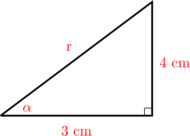Basic Trigonometry
1. Right Angle Triangle

\(\sin \alpha = \dfrac yr = \dfrac {\text{opposite}}{\text{hypotenuse}}\)
\(\cos \alpha = \dfrac xr = \dfrac {\text{adjacent}}{\text{hypotenuse}}\)
\(\tan \alpha = \dfrac yx = \dfrac {\text{opposite}}{\text{adjacent}}\)
\(\sec \alpha = \dfrac {1}{\cos \alpha} \)
\(\csc \alpha = \dfrac {1}{\sin \alpha} \)
\(\cot \alpha = \dfrac {1}{\tan \alpha} \)
2. Special Angles
| \(0\) | \(30^{\text{o}}\) | \(45^{\text{o}}\) | \(60^{\text{o}}\) | \(90^{\text{o}}\) | |
| Sin | 0 | \(\dfrac{1}{2}\) | \(\dfrac{1}{2}\sqrt{2}\) | \(\dfrac{1}{2}\sqrt{3}\) | 1 |
| Cos | 1 | \(\dfrac{1}{2}\sqrt{3}\) | \(\dfrac{1}{2}\sqrt{2}\) | \(\dfrac{1}{2}\) | 0 |
| Tan | 0 | \(\dfrac{1}{3} \sqrt{3}\) | 1 | \(\sqrt{3}\) | ∼ |
Example 01
Given a right angle triangle below:

Determine the value of \(\sin \alpha\), \(\cos \alpha\) and \(\tan \alpha\)
Find the value of \(r\)
\begin{equation*} \begin{split} x^2 + 5^2 & = r^2 \\\\ 3^2 + 4^2 & = r^2 \\\\ 9 + 16 & = r^2 \\\\ 25 & = r^2 \\\\ r & = \pm 5 \end{split} \end{equation*}
Use positive value, \(r = 5\)
\begin{equation*} \sin \alpha = \dfrac {\text{opposite}}{\text{hypotenuse}} = \bbox[5px, border: 2px solid magenta] {\frac {4}{5}} \end{equation*}
\begin{equation*} \cos \alpha = \dfrac {\text{adjacent}}{\text{hypotenuse}} = \bbox[5px, border: 2px solid magenta] {\frac {3}{5}} \end{equation*}
\begin{equation*} \tan \alpha = \dfrac {\text{opposite}}{\text{adjacent}} = \bbox[5px, border: 2px solid magenta] {\frac {4}{3}} \end{equation*}
Example 02
A right angle triangle ABC, given that \(\sin A = \dfrac {5}{13}\).
Determine the value of \(\cos A\) and \(\tan A\)
\(\sin A = \dfrac {\text{opposite}}{\text{hypotenuse}} = \dfrac {5}{13}\)

Find the value of \(x\)
\begin{equation*} \begin{split} x^2 + 5^2 & = 13^2 \\\\ x^2 + 25 & = 169 \\\\ x^2 & = 144 \\\\ x & = \pm 12 \end{split} \end{equation*}
Use positive value, \(x = 12\)
\(\cos A = \dfrac xr = \dfrac {\text{adjacent}}{\text{hypotenuse}} = \bbox[5px, border: 2px solid magenta] {\dfrac {12}{13}}\)
\(\tan A = \dfrac yx = \dfrac {\text{opposite}}{\text{adjacent}} = \bbox[5px, border: 2px solid magenta] {\dfrac {5}{12}}\)
Exercise
